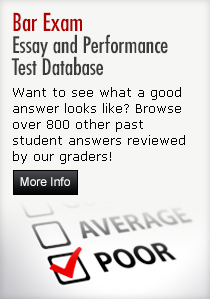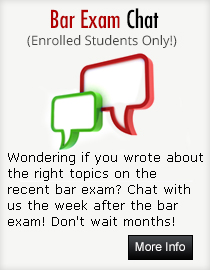Taking the Bar Exam in California? |
Other Bar Exam States
ABOUT THE MULTISTATE ESSAY EXAMINATION (MEE)
During each bar exam, a student must fully complete six or more essays. The essays are usually administered on the first day of the bar exam. Each essay will usually have approximately five to seven main issues. While each state may participate in using the MEEs it is up to each state to decide the weight given for the section and the scoring for each exam.
The following subjects may be tested on your state's MEE section: Business Associations (Agency and Partnership; Corporations and Limited Liability Companies), Conflict of Laws, Constitutional Law, Contracts, Criminal Law and Procedure, Evidence, Family Law, Federal Civil Procedure, Real Property, Torts, Trusts and Estates (Decedents’ Estates; Trusts and Future Interests), and Uniform Commercial Code (Negotiable Instruments (Commercial Paper); Secured Transactions). Additional state specific subjects may also be included for your state bar exam (check your loca state bar website for more info.)
States which require the MEE: Alabama, Arkansas, Arizona, Colorado, Connecticut, District of Columbia, Hawaii, Idaho, Illinois, Iowa, Kentucky, Mississippi, Missouri, Montana, Nebraska, New Hampshire, New Mexico, North Dakota, Oregon, Rhode Island, South Dakota, Utah, West Virginia, Wisconsin. If your state doesn't require the MEE, don't worry! You can still practice our common law subjects in our essay simulator.
Click HERE for more detailed information for your state's bar exam.
PREPARATION FOR THE ESSAYS
It is eight weeks before the bar exam. You have registered for the exam, begun your bar review course, and made your hotel reservations. Are you ready to do some essays? With our guidance, we will try and make it an easy process.
HIGHLIGHTERS, AND OTHER GOODIES
There are special unique items which bar exam candidates should bring specifically for the essays. These are items which are allowed for the essays by the bar examiners. The full list can be found in your instruction booklet provided for you once you've signed up for the exam. However, there are a few items we would like to highly recommend:
(1) Highlighters (at least 2-3 colors): A highlighter is a very helpful tool for the essays. You should try and bring at least 2-3 bright colors. You can use them on different areas of the essay question. For example, you could use a pink highlighter to identify key facts in your essay or a green highlighter to recognize good counter arguments! Highlighters are provided in each of our survival kits.
(2) Miniature Clock (not digital!): Yes, a clock. Not a watch. A clock is crucial to your test taking experience. It is nice that the bar examiners have approved this handy device. A clock is included in each of our survival kits. Place the clock at the corner of your desk. Now, you can use the clock to anchor you with attacking the essays. For example, the clock can help remind you that it is time to finish reading the essay and start writing your outline or vice versa. Time organization is key to doing well on this test!
(3) Ear Plugs: You may not realize it now but I'm sure you can recall how loud your classroom was during exams. Now multiply that by 1,000. Oh yeah, and add some loud bathroom doors! You get the point. Ear plugs are key to staying focused on this exam. Special ear plugs are included in each of our survival kits. Don't waste your money on the type that you can squeeze with two fingers! The firmer, the better!(4) Study Materials: As soon as you decide you are taking the bar exam you need to get your study materials together. Here are a few items we recommend:
(1) The Law: Yes, that's right - the law. Sounds pretty simple doesn't it? However, many students struggle with finding a good book or books to help them adequately prepare for the essays. We at Bar Exam Doctor recommend a book thats been around for many years - The Barbri Conviser. This book is the best source and usually all you really need to do well on this exam! You can get this book online (Amazon, Craigslist, etc.) for usually under $100 - try and get the latest version if possible!
(2) Rule Statements: As you get closer to the bar exam you will need to start memorizing. The best way to do this to make a 1-2 sheet piece of pager (back/front) with the most frequently tested rules for each subject. You can even cherry pick some of the buzz words from the Barbri Conviser. Remember - you want to go with the group!
(3) Approaches: Another important study item is a good set of approaches. Now remember, not every issue requires a full blown approach. However, the most commonly test ones do. Once you've begun memorizing your rule statements and can see the bar exam fastly approaching you can start making these. A good technique is to go take at past bar exam essays from your local state bar website and look at the model answers. Look for issues that are spread out with various elements. Those are usually issues that require lengthy approaches. Now, go and copy the approach. Do the same for the others. By days end you should be able to put all of your approaches on a two sided piece of paper.
TAKING THE TEST
Did you know there are several approaches to doing an essay? Some believe they must follow the approach taught to them in their bar review. Others believe they should use the approach they learned in law school because its all they know. We at Bar Exam Doctor believe in a combination approach - do what you feel comfortable doing but at the same time listen to your bar review instructors. They know what they are talking about!
APPROACHES
(1) Facts then Question:The first approach is to read the facts first and then the questions. This method usually leads a student down to disastererous path. What do we mean by this? Many students read the facts first and then become nervous that they don't know the question so they read it again and start issue spotting and make an extremely long outline. The next thing the know there's 15 minutes left, they typed an answer, and just realized they didn't answer any of the questions. This is can hurt their performance. The National Bar Examiners know what they are doing. This method works for some students but not for most. The call of the question is designed to lead the student to the issues at hand. While a student may believe they are spotting issues on the essay and on the path to success, they may not be spotting the issues the bar examiners are looking for!
(2) Question then Facts: The second approach is generally more favorable to students. We at Bar Exam Doctor and most Bar Review instructors prefer this method over the former because it leads a student to the issues the bar examiners are looking for. Even though this method is preferred by instructors more, it is actually similar to the first method (if a student has issue spotted past exams and generally knows the issues the examiners continue to test they can still usually spot the right issues!) There are usually five to seven main issues that will be repeated throughout each question. The main issues need to be discussed thoroughly. Some students think that because they see an issue on an essay that it must be discussed! Be cautious when identifying issues. Sometimes, only certain issues are being tested on that essay!
(3) Topic Approaches: Before taking the bar exam the student should make sure that they have a good approach to major issues which are tested over and over. Here are a few examples of areas we feel a student should expect to be tested on:
(1) Civil Procedure: Personal Jurisdiction, Diversity, Choice of law, venue, class action, Res Judicata, and Collateral Estoppel
ORGANIZATION
(1) Materials: Organization is key to doing well on this test. Organization is both important for physical items on your desk as it is for words on your answer! Students often become over anxious and rip out and throw all of their essay questions in a pile once the books are handed out. Try not to do this. While the proctors are counting students and getting ready to hand out books, place your items neatly around you. For example, you may want to place your clock at the corner of your desk and your highlighters to your right. Placement is key to keeping you focused during the test. The last thing you want to worry about is finding your green highlighter!
(2) Outline: I'm sure you know from your essay preparation that outlines are like gold for doing well on this test! Students don't realize how important an outline is for a good essay. Whether you read the facts first or second, the key issue is to read them slowly! Slowly, slowly, slowly! We can't stress this enough. For example, if you read the facts too fast you may miss key facts that point to a major issue which you fail to include in your outline thus leading you to an incomplete essay. Remember, no points are given for effort, so make sure everything gets onto your answer!
(3) Answer: The answer is the most important document of this exam. I'm sure you know why! Without the document, you can't pass the test! Students often forget how important a clean and concise essay is!
Headings: Headings are essential to a passing score on the essays. The bar examiners don't tell you how to do this. You need to prepare doing these ahead of time. This shouldn't be the first time you are doing this! Headings should always be concise and complete. Meaning that they should apply the facts and law and mostly support your argument. Don't just repeat the law or facts! Also, try and either write them in caps or underline them. Roman numerals are not necessary.
Spacing: Students don't realize how much spacing helps a student's answer. Remember, you want your answer to look clean and concise! For example, space your headings throughout your entire answer. Make the document look as real as possible!
Spelling: Many students hate to spell check their answers! Have you ever read a good answer and then found several typos? It doesn't look good. Try and allocate five minutes before you're done with the exam and read your answer top to bottom. It all helps!
(4) Time allocation: There are several theories for allocating the proper amount of time for each step of writing a good essay. At Bar Exam Doctor, we believe our students should allocate approximately 5 minutes to reading the facts and questions (atleast twice!) and separating their materials accordingly. The next 20 minutes should be allocated to outlining. The next 30 minutes should be spent writing the essay. Because the answer is so important - take your time. Do a good job outlining the essay so you don't have to go back and cherry pick! The last 5 minutes should be spent reading over your answer. Check your spelling, spacing, headings, etc! Would you feel confident submitting this to a judge? The answer should be yes!
AFTER THE TEST
Relax! Please? It's over. The hard work is done. You have done everything possible. Don't second guess your work. Everything will work out. Now, go take a swim at the beach or go see that movie you've been waiting to see!
*All information about the grading process has been taken directly from the National Bar Examiners website.
Testimonials
"This was my third attempt at the California Bar and thanks to Bar Exam Doctor I passed!! I am extremely grateful for all the helpful tips which helped me pass the essay portion of the exam. Thank you!!!.
Reema R., Esq.
"I passed--in part due to your graders detailed comments. Your service was definitely worth my time and money. I have already recommended you to several people from my school. Thanks again."
Michael L., Esq.
"I recommend the Bar Exam Doctor if you need to drastically improve your scores. I went from mid 50s on my essays and PTs to passing the the Bar Exam after using their service."
Reuben A., Esq.
"I finally passed!"The Bar Exam Doctor graders gave me more extensive and helpful feedback on my essays and PTs than I received at any other bar review, including Barbri and Barwinners!














